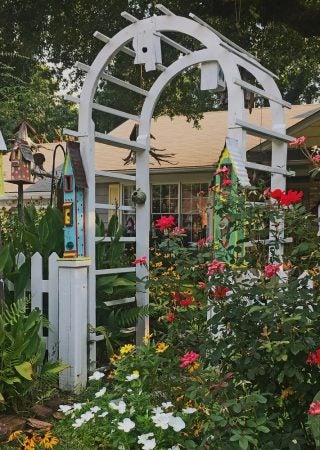Seasonal changes are gates to step through
Published 1:30 pm Sunday, December 12, 2021
|
Getting your Trinity Audio player ready...
|
Seasonal changes throw us across emotional thresholds we would just as soon not exist. But they’re just gates to step through.
I try to balance straightforward how-to garden columns with more thoughtful what’re-we-doing-here ditties. This is one addresses how, when handling dramatic seasonal changes, we either step across and embrace the new, or get dragged, weeping over the losses.
In her book The Solace of Open Spaces, Gretel Ehrlich admits that in this season she feels “a double voice: one says everything is ripe, the other says everything is dying. The paradox is exquisite.”
It’s like having flowers with caterpillars. I’m dismayed when I lose my investment in money, effort, and time in the garden, and use netting to protect what I can. But monarch butterflies can’t survive without milkweed for their larvae to feed on, and gulf fritillaries depend on passionflower vines; mentally accepting that caterpillars are as important as butterflies and knowing that the flowers will be back next year, but the butterflies won’t if I don’t help them (it’s not up to someone else), I share my toys. I calm myself by looking at them closely, appreciating how my garden supports wildlife.
But back to dealing with the oncoming Winter. A lot of non-native flowers and veggies are still going full-tilt boogie when a freeze finally cuts them down. And for those of us passionately attached to seasonal flowers, the dramatic gap left when tomatoes, elephant ears, zinnias, lantana, ornamental sweet potatoes, and canna melt into greenish-brown goo can easily be heartbreaking.
This sort of threshold, by the way, is called a limen, and our natural thoughts and emotions are very similar to those “betwixt and between” feelings we share during the countdown on New Year’s Eve. And flying in an airplane, suspended between two distinct places. And while going through a garden gate.
Luckily, on top of gorgeous displays of Autumn foliage and newly colored up berries, we Southerners are cheered on by gorgeous fall-flowering sasanqua camellias, fragrant sweet olive and eleagnus, colorful winter-migrant birds, and a few very early paperwhite narcissus. And even the required raking of leaves is psychological; by forcing us to deal physically with the change, it gives us the time and opportunity to ponder the impermanence of it all.
So, ponder this: By paying ritualistic attention to little details, Japanese gardeners celebrate changes. They deliberately embrace how beauty is almost always tinged with sadness – even as cherry trees are in full bloom, they take time to pick up and examine fallen petals. I scatter old, weathered objects in my garden as a subtle nod to rustic impermanence.
Their term for this sensitivity to ephemeral, impermanent events is mono no aware; it is the “ahh” or “ooh” response of watching a sunset, seeing shooting stars or fireworks, coming across sweet new flowers, or whiffing a passing evening fragrance.
This mindful, moment-to-moment awareness, paying attention to things we ordinarily never give a moment’s thought to, keeps us conscious of here-and-now, of where we are rather than stumbling from one event to another. Awareness of the transience of all things, while embracing the sadness at their passing, also heightens appreciation of their beauty.
This season is a hard transition from summer glory and warmth to cold winds and rain and only a few of the hardiest flowers venturing forth. How we handle the change, our rites of passage, help mark and celebrate the cycle of nature.
Instead of fretting, make liminal lemonade. Savor the change by kicking some leaves, look closely at a camellia, and trust there to be daffodils on the other side.
Felder Rushing is a Mississippi author, columnist, and host of the “Gestalt Gardener” on MPB Think Radio. Email gardening questions to rushingfelder@yahoo.com.






